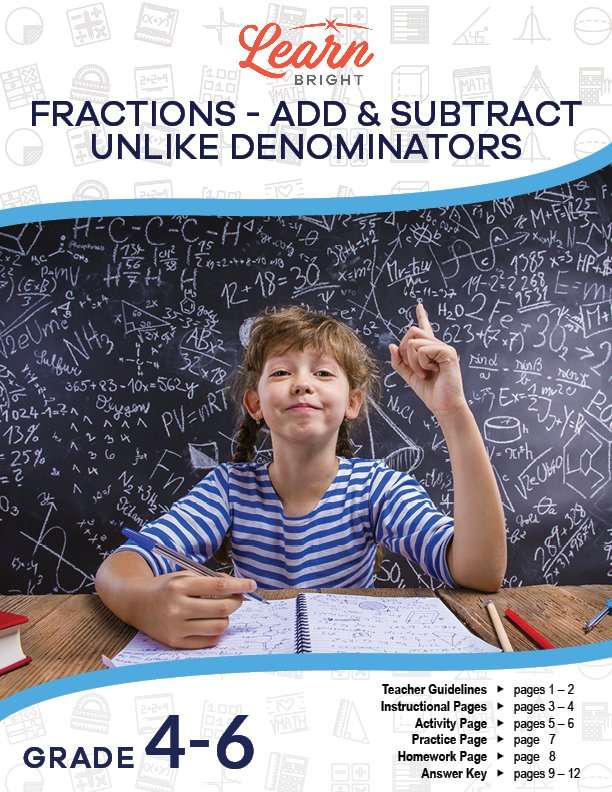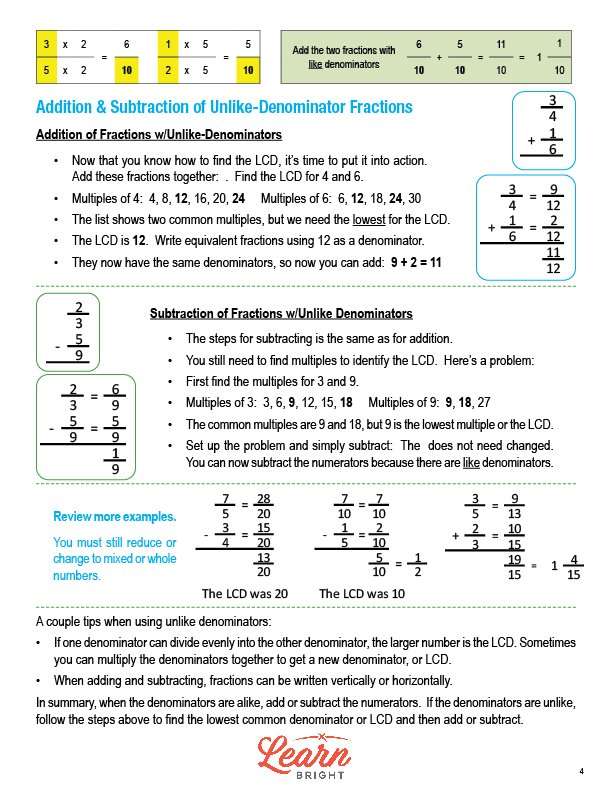Description
What our Fractions—Add and Subtract Unlike Denominators lesson plan includes
Lesson Objectives and Overview: Fractions—Add and Subtract Unlike Denominators teaches students how to find the lowest common denominator to add and subtract fractions with unlike denominators. Students will expand their vocabulary with terms like LCM and LCD. At the end of the lesson, students will able to find the lowest common denominator, and add and subtract fractions with unlike denominators. This lesson is for students in 4th grade, 5th grade, and 6th grade.
Classroom Procedure
Every lesson plan provides you with a classroom procedure page that outlines a step-by-step guide to follow. You do not have to follow the guide exactly. The guide helps you organize the lesson and details when to hand out worksheets. It also lists information in the blue box that you might find useful. You will find the lesson objectives, state standards, and number of class sessions the lesson should take to complete in this area. In addition, it describes the supplies you will need as well as what and how you need to prepare beforehand.
Options for Lesson
Included with this lesson is an “Options for Lesson” section that lists a number of suggestions for activities to add to the lesson or substitutions for the ones already in the lesson. One optional addition to the lesson is to have your students create word problems using the activity fractions and exchange them with other students. If you’d like to add an evaluation to the lesson, you can use the practice and homework pages as a quiz or short test. If you have students who have trouble understanding equivalency between fractions, you can use fraction manipulatives. Another optional activity idea is to have your students create real-life fraction word problems and exchange them with another student to complete. You could also have your students use the content pages and steps to create their own “How to” poster for adding and subtracting fractions with unlike denominators. Finally, you could have your students write down how to solve a fraction addition problem with unlike denominators using text only to make sure they understand the lesson concepts.
Teacher Notes
The teacher notes page includes a paragraph with additional guidelines and things to think about as you begin to plan your lesson. This page also includes lines that you can use to add your own notes as you’re preparing for this lesson.
FRACTIONS—ADD AND SUBTRACT UNLIKE DENOMINATORS LESSON PLAN CONTENT PAGES
Multiples
The Fractions—Add and Subtract Unlike Denominators lesson plan includes two pages of content. When you see the word multiple, you probably think of multiplying! In math, we find a multiple of a number when we multiply it with another number. For example, to find multiples of 2, you multiply 2 x 1, 2 x 2, 2 x 3, 2 x 4, 2 x 5, and so on. The multiples of 2 are therefore 2, 4, 6, 8, 10, 12, and so on. All numbers have multiples!
Some multiples of 3 are 3, 6, 9, 12, 15, 18, 21, and 24, and some multiples of 4 are 4, 8, 12, 16, 20, 24, and 28. Numbers can have common multiples, or multiples that are the same between two or more numbers. Look at the multiples of 3 and 4. When you look at the lists, you can see that they have common multiples of 12, 24, 36, and more. Being able to identify common multiples will help you add and subtract fractions with different denominators.
As a reminder, the denominator is the bottom number of a fraction. When you add or subtract fractions, the fractions have to have the same denominator. If they do not already have the same denominator, you need to change them to the lowest common denominator.
Finding Lowest Common Denominators
The lowest common denominator (LCD) is the same thing as the lowest common multiple (LCM). In the example above, the lowest common multiple of 3 and 4 is 12, so the lowest common denominator of 3 and 4 is also 12.
To find the LCM/LCD for 2 and 5, for example, you first need to look at the multiples of both of the numbers. Some multiples of 2 are 2, 4, 6, 8, 10, 12, and 14 and some multiples of 5 are 5, 10, 15, 20, 25, and 30. Both lists of multiples have the number 10 on them, so 10 is the LCM/LCD.
Now that you know how to find the LCD, you can use it to create equivalent fractions. We can use fractions with 2 and 5 in the denominators as an example. Say that we want to add 3/5 and 1/2 together. To solve, we will multiple the current fractions by 2 and 5, because this will result in a denominator of 10: 3/5 x 2/2 = 6/10 and 1/2 x 5/5 = 5/10. We can then add them together and reduce to solve: 6/10 + 5/10 = 11/10 = 1 1/10.
Addition & Subtraction of Unlike-Denominator Fractions
The lesson walks through an addition problem and subtraction problem step-by-step to reinforce understanding.
Addition
The example addition problem is 3/4 + 1/6. First, we need to find the LCD of 4 and 6, because they are the two denominators. The multiples of 4 include 4, 8, 12, 16, 20, and 24 and the multiples of 6 include 6, 12, 18, 24, and 30. There are two common multiples in these lists, 12 and 24. However, we’re only looking for the lowest common multiple, which is 12. Therefore, the LCD is 12!
Now that we know the LCD, we can create equivalent fractions using 12 as a denominator: 3/4 x 3/3 = 9/12 and 1/6 x 2/2 = 2/12. We multiply 3/4 by 3/3 because we need to multiply the denominator, 4, by 3 to get the LCD of 12, and we must multiply both the numerator and denominator by the same thing to create an equivalent fraction. This is also why we multiply 1/6 by 2/2. 6 x 2 = 12 and we need to multiply the numerator by the same number. Finally, we can solve by adding the new fractions: 9/12 + 2/12 = 11/12.
Subtraction
Next, the example subtraction problem is 2/3 – 5/9. We follow the same steps as the addition problem. First, we need to find the LCD of 3 and 9, because they are the two denominators. When we look at the multiples of 3 and 9, can see that 9 is the lowest common multiple, which means it is also the LCD. Next, we create equivalent fractions. Because one of the fractions already has the LCD (9) as its denominator, we do not need to do anything to it. To create an equivalent fraction for 2/3, we multiply 2/3 x 3/3 to get 6/9. Finally, we subtract as usual: 6/9 – 5/9 = 1/9.
The lesson closes with some helpful tips for working with unlike denominators. If one denominator can evenly divide into the other, the larger number is the LCD. Also, when adding and subtracting, you can write the fractions vertically or horizontally.
In summary, when the denominators are alike, add or subtract the numerators. If the denominators are unlike, follow the steps above to find the lowest common denominator or LCD and then add or subtract.
FRACTIONS—ADD AND SUBTRACT UNLIKE DENOMINATORS LESSON PLAN WORKSHEETS
The Fractions—Add and Subtract Unlike Denominators lesson plan includes three worksheets: an activity worksheet, a practice worksheet, and a homework assignment. You can refer to the guide on the classroom procedure page to determine when to hand out each worksheet.
DRAW A PICTURE ACTIVITY WORKSHEET
For the activity worksheet, students will draw a picture showing the lowest common denominators for each of the six given pairs of fractions.
ADD OR SUBTRACT PRACTICE WORKSHEET
The practice worksheet asks students to add or subtract fractions to solve each problem. They will then reduce or change to a mixed or whole number if necessary.
FRACTIONS—ADD AND SUBTRACT UNLIKE DENOMINATORS HOMEWORK ASSIGNMENT
For the homework assignment, students will solve eight fraction word problems. They will then reduce their answers or change them to a mixed or whole number if necessary.
Worksheet Answer Keys
This lesson plan includes answer keys for the activity worksheet, the practice worksheet, and the homework assignment. If you choose to administer the lesson pages to your students via PDF, you will need to save a new file that omits these pages. Otherwise, you can simply print out the applicable pages and keep these as reference for yourself when grading assignments.









